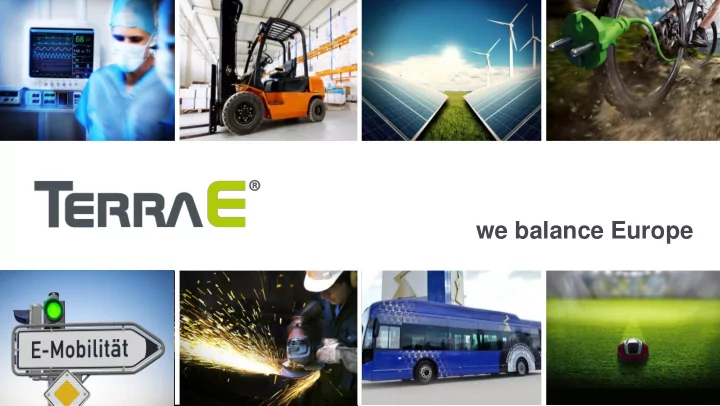

we balance Europe 11/26/2017 1
Mod Modular ular Li Li-Ion Ion ce cell ll pr prod oduc uction tion with with zer ero CO o CO 2 foo ootp tprint rint 1. Why in Germany/Europe 2. Unique opportunity 3. Our sequential und parallel plan 4. TerraE CO 2 footprint Organization 11/26/2017 2
Why in Germany/Europe? 1. Huge local demand in Europe 2. The logistic for an European-based cell production is easier 3. Industry consortium available 4. High level of renewable energy 5. Strong R&D competence 6. Experienced machine and plant builder with strong Li-Ion experience 7. Financial Government an EU support for the starting phase 8. Significant local supplier market 11/26/2017 3
Unique opportunity Demand of Li-Ion cells Production Capacity Cell price Summary time today 11/26/2017 4
TerraE growth plan to serve increasing customer demands 12 Non-Automotive 10 Planned capacities (in GWh) 8 6 4 2 0 2017 2018 2019 2020 2021 2022 2023 2024 2025 2026 2027 2028 25 Automotive 20 Planned capacities (in GWh) 15 10 5 0 2017 2018 2019 2020 2021 2022 2023 2024 2025 2026 2027 2028 Phas hase 1 e 1 Phas hase 2 e 2 up t to 1,5 1,5 GWh 34 G GWh 11/26/2017 5
TerraE defines Two-Steps- Strategy to serve market’s need Ph Phase ase 2 Prepare capacity for serving the automotive Ph Phas ase e 1 market in 3 years with following strategy Serve the industrial market first and immediately Synergy Syner y fr from Phase 1 om Phase 1 to be g to be graded aded in Phase 2 in Phase 2 11/26/2017 6
Europäische Batterie-Allianz Summary 11/26/2017 7
Planning group for highly modern Giga-Fab is led by TerraE 11/26/2017 8
Su Summa mmary y of of Sw Swed edish ish St Stud udy, , May May 20 2017 17 Focus of the Study • Analysis of Greenhouse Gas ( GHG ) Emissions and Energy Use for Li-Ion Battery Production • Recommendations for a CO 2 neutral Electric Car fleet • Literature Review on – Lithium-ion batteries for light-duty vehicles – Energy consumption and greenhouse gas emissions – Current and near future chemistries • Lithium iron phosphate (LFP) cathodes • Lithium nickel manganese cobalt oxide (NMC) cathodes • Lithium manganese oxide (LMO) cathodes • Graphite anodes
Find Findings ings Lif Life Cy e Cycle le As Asse sess ssme ment nt with with th the Sp e Spec ecifi ific c GHG GHG Foo ootp tprin rint Mining Material Battery Recycling Processing Manufacturing • Total • Total • Total 48 – 121 (216) 18 – 50 20 -110 • Most likely • Most likely 15 • Most likely 60 -70 • Pyrometallurgy 70 -110 Total and Most likely values in kg CO 2 -eq/kWh [Table 24, page 39] The studies indicate greenhouse gas emissions of 120-250 kg CO 2 -eq/kWh. Based on the assessment of transparency and scientific method this report views a range of 150-200 kg CO 2 -eq/kWh as the most likely impact. [page 28] Comment: The range is w.r.t. a fossil share of 50-70%. w.r.t. = with reference to
Calculation of GHG Footprint based on the Study Results Car Battery Size [kWh] 150 kg CO2-eq/kWh 200 kg CO2-eq/kWh Tesla Model S 86 12.9 t CO2 17.2 t CO2 Nissan Leaf 23.8 3.6 t CO2 4.8 t CO2 This calculation shows the GHG Footprint of two batteries with the assumed data from the report. The range of 150 – 200 kg CO2 eq/kWh is w.r.t. a fossil share of 50-70%. About 60% of the emissions are from the battery manufacturing process. Assuming we can use 100% renewable energy in the manufacturing process, we can reduce the GHG Footprint by 60%. Car Battery Size [kWh] 60 kg CO2-eq/kWh 80 kg CO2-eq/kWh Tesla Model S 86 5,2 t CO2 6,9 t CO2 Nissan Leaf 23,8 1,4 t CO2 1,9 t CO2 w.r.t. = with reference to
CO 2 Footprint of ICE and Electrical Powered Cars EPC (Study) ICE PC EPC (TerraE) 14000 IVL Study based result German electricity mix in 2015: 535 g CO2/kWh ~ 2.5 years for break-even 12000 Assumptions: • 7 l/100 km: 165 g CO2/km (tank to wheel) 10000 • 18 kWh/100 km (plug to wheel) KG CO2-EQ • 15,000 km/a average driving distance 8000 6000 4000 TerraE target 2000 ~1.5 years for break-even 0 0 10 000 20 000 30 000 40 000 50 000 60 000 70 000 DRIVING DISTANCE [KM] 11/26/2017 12
willing to join? 11/26/2017 13
Recommend
More recommend